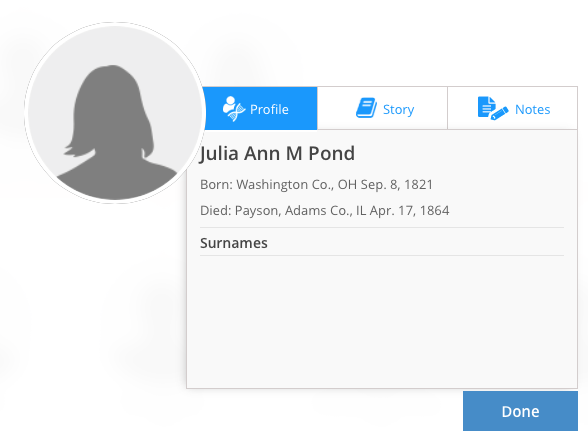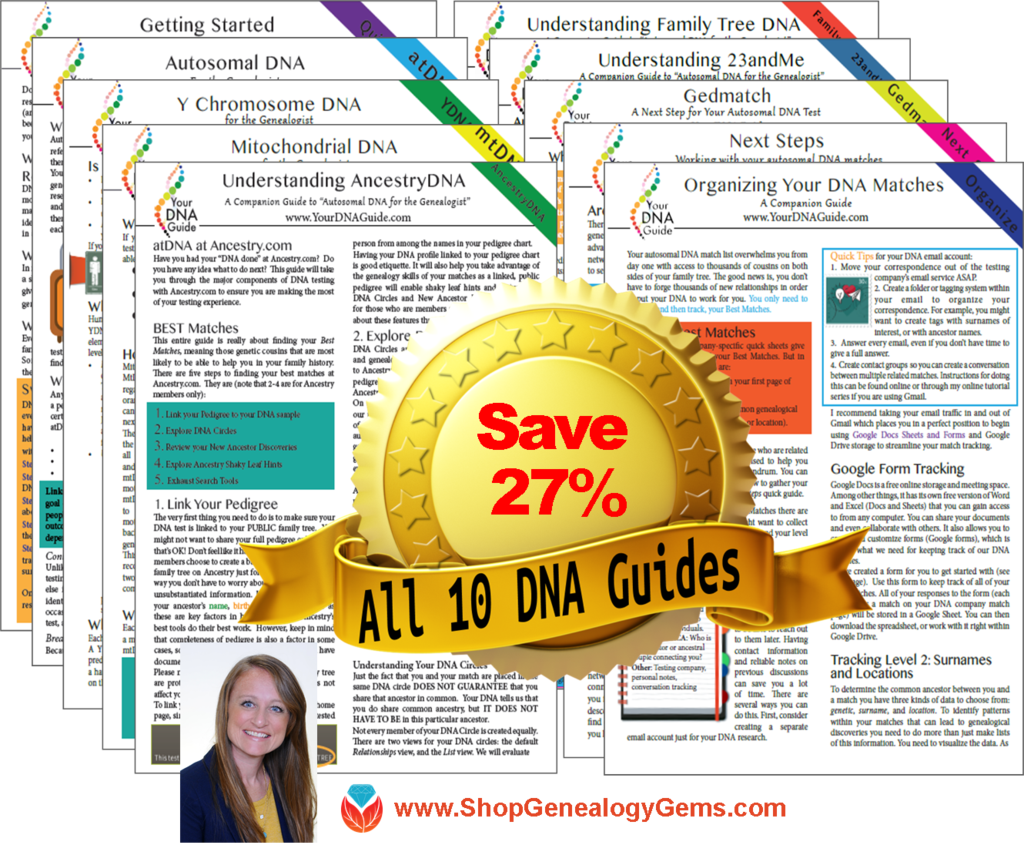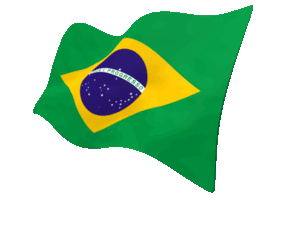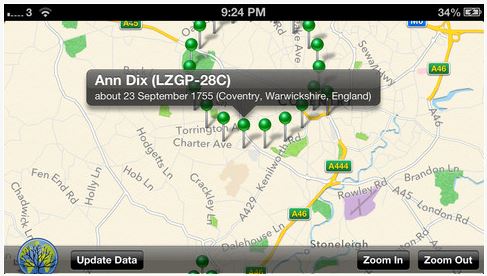How to Get Back Into Genealogy
Show Notes: Restart Your Genealogy!
Has it been a while since you worked on your genealogy research? As passionate as we may be about genealogy, the reality is that a little thing called “Life” can get in the way!
Getting back into genealogy can actually be a bit daunting. Where did you leave off? Where should you start back up?
If it’s been months or even years since you had your hands in genealogy, you’re in the right place. In this video, we’re going to talk about how to pick up your genealogy after a hands-off spell so that you can quickly and efficiently get back on the trail of your ancestors.
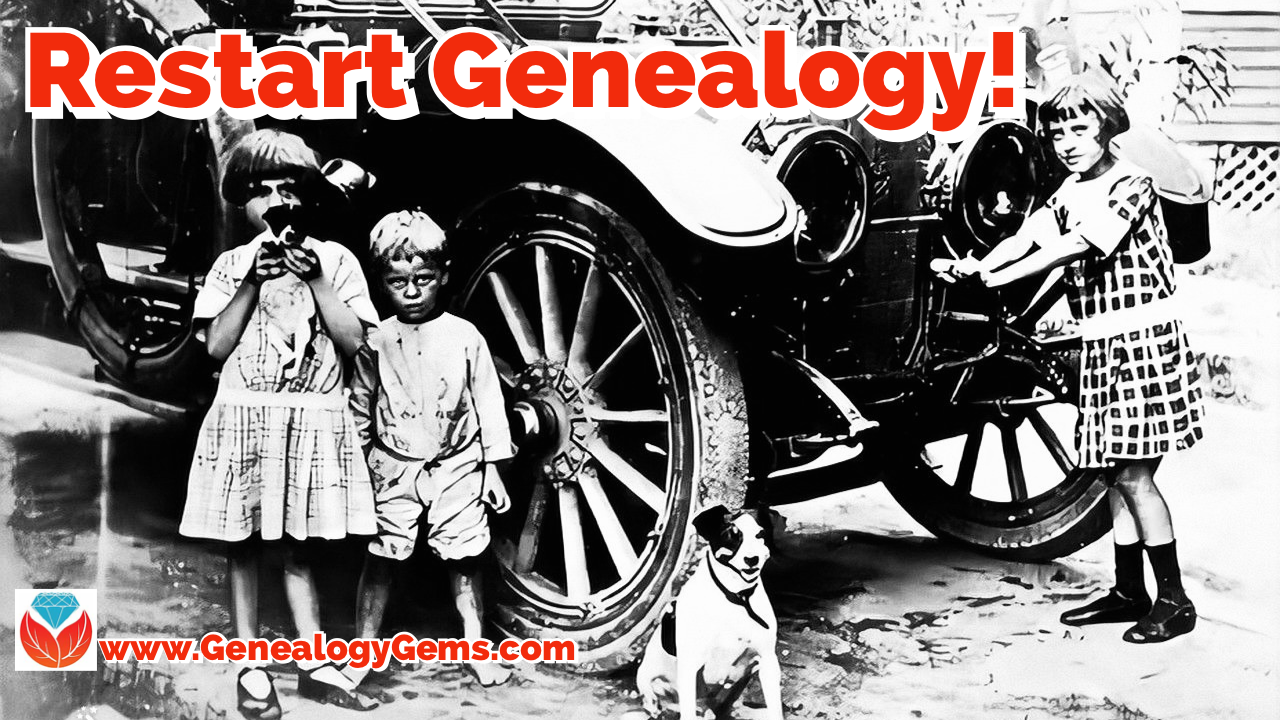
Get your Genealogy Restart checklist in the Resources section.
And by the way, perhaps you haven’t taken a break, but you feel like you’ve gotten a little out of control and disorganized in what you’ve been doing so far. This process also works very nicely as a quick audit to help you get back on track.
How to Jump Back into Your Genealogy
Has it been a while since you worked on your genealogy research? As passionate as we may be about genealogy, the reality is that that little thing called life can get in the way.
In my case, my daughter got married earlier this year. There were plans to make, bridal shows to throw, and the wedding itself which meant planning a trip because it was a destination wedding. Needless to say, I didn’t work on family history for several months.
If it’s been months or even years since you had your hands in genealogy, you’re in the right place. In this article and companion video we’re going to talk about how to pick up your genealogy after a hands-off spell so that you can quickly and efficiently gets back on the trail of your ancestors.
Even if you haven’t taken a break, you might be feeling a little out of control and disorganized in what you’ve been doing so far. This quick genealogy audit can help you get back on track too!
Genealogy Restart Checklist
I love a good to-do list where I can have the satisfaction of checking things off and knowing that at the end of it I have accomplished something. Some of the things on this list may not apply depending on how long your genealogy hiatus has been. If that’s the case you get to check them off right away!
Get my comprehensive downloadable Genealogy Restart Checklist. (Premium Membership required)
Step 1: Find Out Where You Left Off in Your Research
Do you remember where you left off the last time you were researching your family tree? If not, your search history is a great place to start. For example, if you used the popular genealogy website Ancestry.com you can pull up your past search history.
How to find your search history at Ancestry.com
At the Ancestry® home page you will see a box at the top that highlights the recently modified items in your family tree. According to one source at Ancestry.com, this “shows a list of last modified nodes in the tree. For a shared tree – any user who has access to the hint can modify the nodes and it will show up in that list. It (also) shows a hint leaf for the nodes that have at least one undecided hint.”
This could be a place to start, but I recommend reviewing Your Recent Searches if you want to pick up where you left off.
You’ll find your search history in the menu under Search. Click All Collections. Toward the top of the All Collections page you’ll see Your Recent Searches. It’s just above the map. You’ll see a few buttons listed for the most recent names you searched. Next, click the View All button to get a more comprehensive view of your activity history, starting with the most recent activity.
On the Recent Activity page, you’ll see the names you searched for and the details you included such as a place and time frame. Ancestry also tells you the date you ran the search.
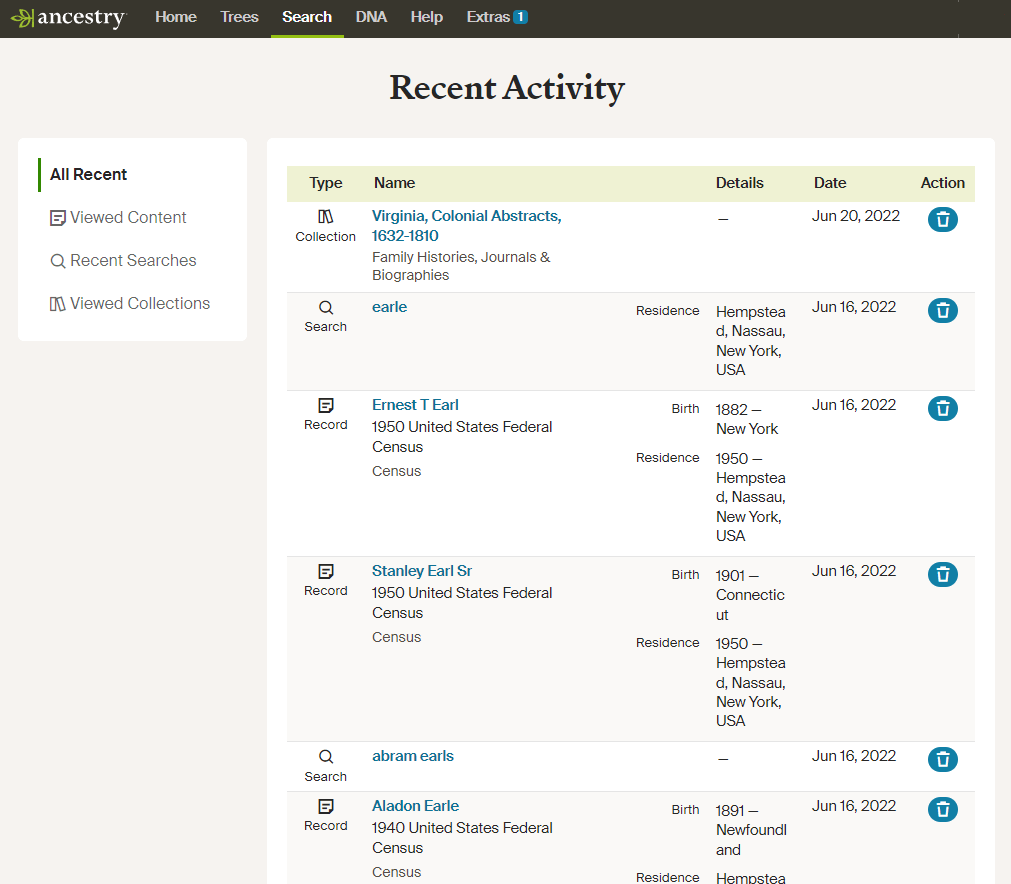
Recent Search History page at Ancestry®
If you see searches in the list that you don’t need anymore, click the trash can button to delete them.
Notice over on the left that you are viewing Recent Searches, but you do have other options:
- All Recent (activity)
- Viewed Content (records you’ve viewed)
- Viewed Collections (record collections you accessed)
All Recent provides the best overall picture of your past search history. This is a great tool for jogging your memory and helping you decide where to pick back up.
Review your activity history in your genealogy software.
You can also review your most recently activity in your genealogy database software.
In RootsMagic for example, in the menu go to Search > History or click the History tab at the top of the side bar on the left side of the screen.
Step 2: Identify Gaps that Need to be Filled
Many people enjoy focusing their research on their direct ancestors (grandparents, great grandparents, etc.) While you may have traced back many generations, you may have missed a few things along the way. This is a good time to start with yourself and work backwards through the direct ancestors in your family tree. Look for gaps in your timelines and information, and then start back up by researching to fill them in. Of course, you can also do with any relative that you want to learn more about.
Once you’ve identified the person you want to work on, create a research plan. If you’ve never created a research plan before, don’t worry, it doesn’t have to be complicated. You create and track it on paper, a spreadsheet or any number of notetaking programs. The important thing is that you identify:
- your specific research question,
- the records you think you’ll need to answer it
- the locations where you think those records may be housed.
See this in action in my video Hard to Find Records, a Case Study.
Premium Members check out these classes with downloadable handouts:
- How Alice the Genealogist Avoids the Rabbit Hole which includes creating a research plan.
- Using Evernote to Create a Research plan
Step 3: Prepare for Genealogy Research Success Going Forward:
Since you’re picking your genealogy back up, this is the perfect time to check to make sure you’re set up for success going forward. These remaining items will help ensure that your new discoveries will be well-documented, organized, and protected from loss.
Genealogy software database
If you already have genealogy database software, open it up and see if there’s a newer version available. Look for Check for Updates in the menu.
If you don’t have a genealogy database software program on your computer, go get one now! We’re talking about a software program that you install on your computer. It’s a database specifically designed to record all the information you find. It keeps it organized and searchable, allows for source citations, photos, links, and more. It also gives you tremendous flexibility in running reports. This is something with which an online tree can’t compete. And most importantly all your data resides on your computer hard drive. This means it’s completely within your control and not subject to a paid subscription, or problems with a website such as the site being closed or sold off. The tree you build can be synced to an online tree if you wish to do so. Back in the old days (early 2000s) a database on your computer was the only option, and it remains your best option today.
Genealogy software is typically very affordable. You can even download Family Tree Builder at MyHeritage for free. If you’re willing to invest a few dollars there are several excellent programs to choose from such as RootsMagic, Family Tree Maker, Legacy, etc. I use RootsMagic but all of these programs have been around a long time and are great. The one you pick really depends which user interface you like, and to what extent you may want to sync your tree online.
Premium Member Resource Video: Take Control of Your Family Tree.
Cloud backup
If you don’t have a cloud backup program running on your computer, now is the time to get one. What’s the point of restarting your genealogy research if you’re going to risk losing everything if your computer is damaged or stolen? I’ve used Backblaze for years because it’s reliable, affordable, has an app, and automatically backs up all my files including video. There are several out there to choose from. The important thing is to pick one and get it installed on your computer. It will run automatically in the background, giving you peace of mind that your files are backed up offsite on the cloud in a secure location.
Status of Genealogy Website Subscriptions
Now that you have the tools you need to restart your genealogy research, it’s time to check genealogy websites. Did you have subscriptions to some of the popular genealogy websites like MyHeritage or Ancestry? Log in and go to your account to see if they are still active, and if they are, when they are set to renew. This will help you decide where to spend your time first. Start with the subscription that is up for renewal first. Then you can determine if you want to allow it to renew or cancel and try another genealogy website subscription to round out your research.
If you don’t have any current subscriptions, consider focusing first on familysearch, the largest free genealogy website. Then, depending on your research goals, you can select the paid subscription(s) that will support your research plan.
A Paper Filing System
While we don’t generate as much paper these days as we used to, some paper is inevitable. Don’t add to the paper clutter. If you don’t have a paper filing system in place, take a moment and set one up. Pick a filing system and stick to it. Then as you start your genealogy research you’ll always have a place to put things.
Filing Digital Content
The same goes for digital files as goes for paper files. Don’t jump back into your research without a filing system in place. It’s important to download the digital records you find so that you have access to them even when your subscriptions run out. Avoid a messy computer and commit to a digital filing system and filing name convention.
Check out all of my organization system classes.
Source Citation Brush Up
Were you citing your sources consistently when you last worked on your family history research? If not, STOP EVERYTHING and watch my video Source Citations for Genealogy. Citing your sources will save you headache down the road. You may discover that a previous conclusion was incorrect, and you’ll want to review the source where you got that information. A downloaded record usually doesn’t include specific details as to where you go it. Going forward, as you download records and add the details into your database be sure to also add the source citation.
With this in mind, familiarize yourself with the source citation tool in your genealogy program. If it looks daunting, don’t panic. Head to the menu and click Help, and then search for source citation. There you’ll find the instructions you need to once and for all get a handle on how to cite sources in your software.
Now’s the Time to Restart Your Genealogy
Don’t let the passing of time stop you from getting back into your favorite hobby. By following this checklist you will quickly get back into goal-oriented research and exciting discoveries about your family.
Resources
Downloadable ad-free Show Notes handout (Premium Membership Required.)
Bonus Download: Genealogy Restart Checklist (Premium Membership required)



